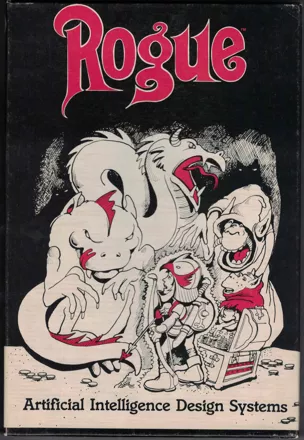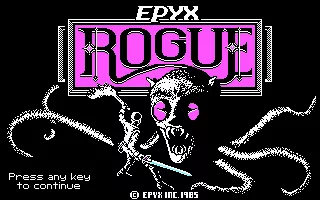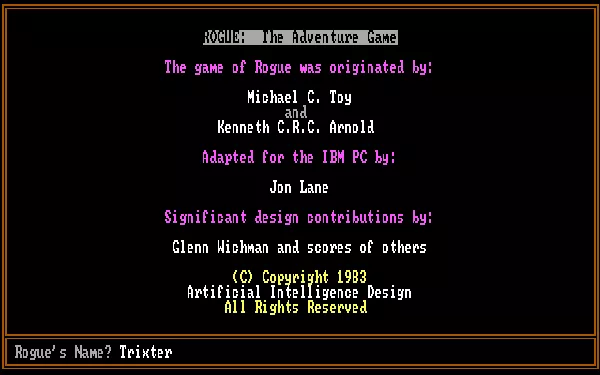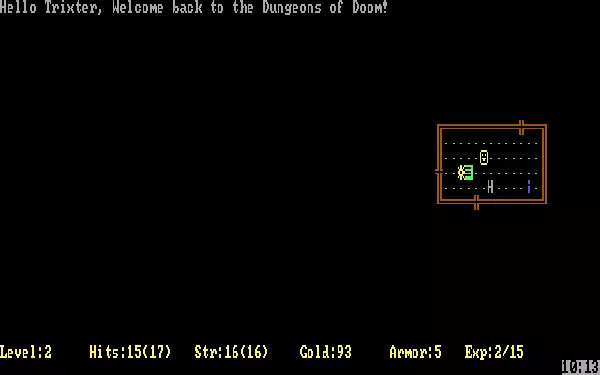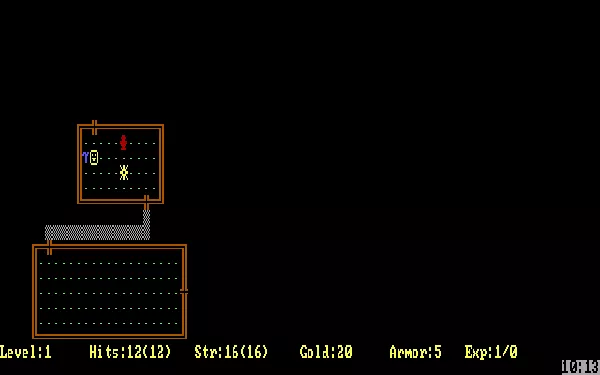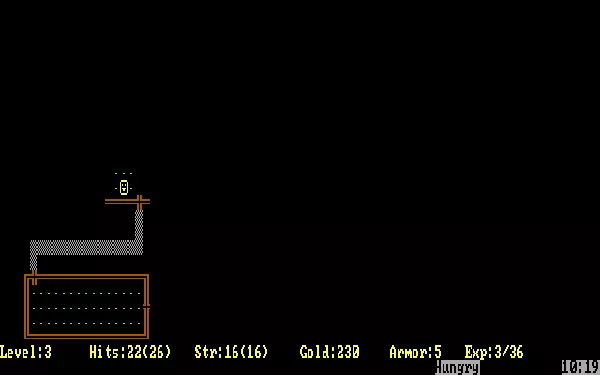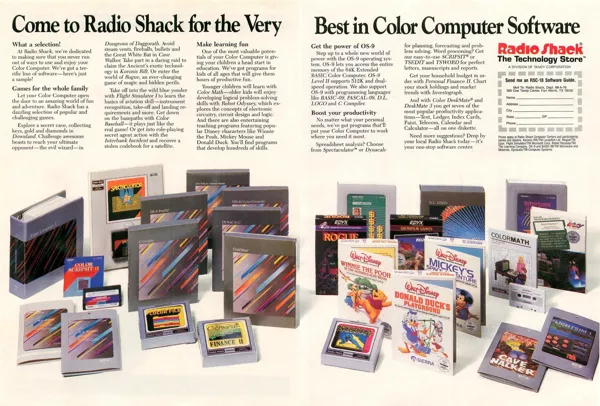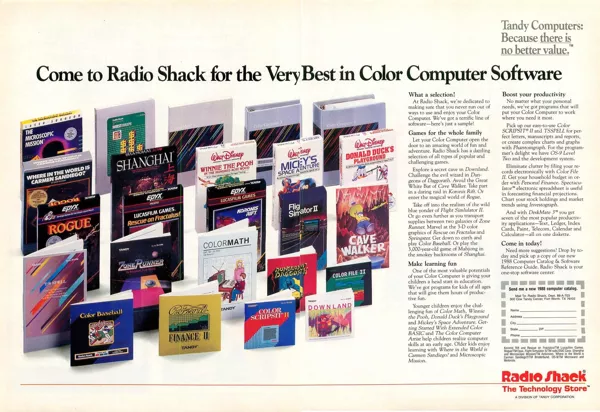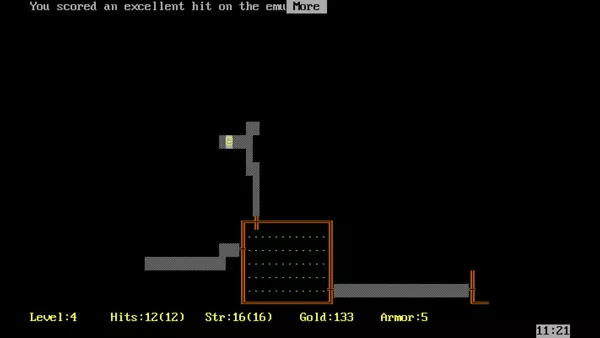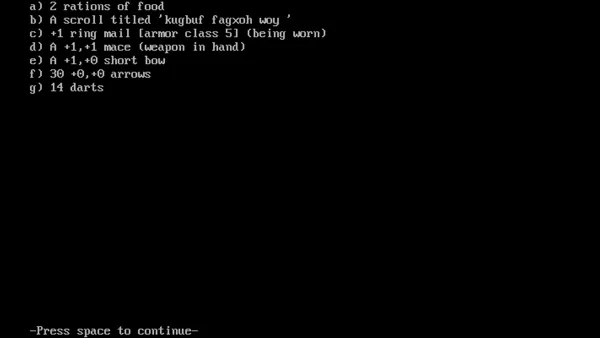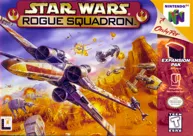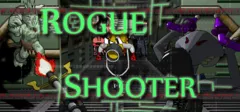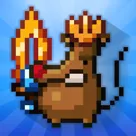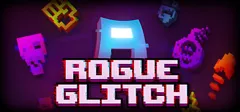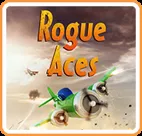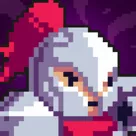Rogue
Description official descriptions
Rogue is a turn-based dungeon crawler in which the player controls an adventurer who must explore the dangerous Dungeon of Doom in order to retrieve the precious Amulet of Yendor and make it out alive. The player character starts on the upper-most level and slowly makes his way downwards.
The game uses ASCII characters to represent locations, items, monsters, and the protagonist himself. There are twenty-six different types of monsters, symbolized by their initial letters (e.g. L for Leprechaun). Monsters have different abilities and modes of attack. The dungeon and the items in it are randomly generated each time the player begins a new game. Each dungeon level contains a grid of three by three rooms and dead ends.
Levels get progressively more complex and maze-like, and monsters grow in strength the deeper the hero ventures into the dungeon. The player character can acquire better weapons and armor, gain experience points and level up. Should the protagonist perish in the dungeon, the player must restart the game anew.
Spellings
- ローグ - Japanese spelling
Groups +
Screenshots
Promos
Credits (DOS version)
19 People (5 developers, 14 thanks)
| Original Concept | |
| Adapted for the IBM PC by | |
| Significant design contributions by | |
| A Guide to Dungeons of Doom by | |
| Special Thanks |
|
| Public domain version of Rogue written by |
Reviews
Critics
Average score: 53% (based on 9 ratings)
Players
Average score: 3.4 out of 5 (based on 74 ratings with 7 reviews)
The Good
Rogue was created around 1980, so it is more than 30 years old. And still it is one of the most playable and re-playable games that I ever played.
It's not a coincidence that Rogue started a whole sub-genre of "Rogue-likes", just like the original Colossal Cave ADVENT started the adventure genre. Similarly, not only the idea is great and innovative (for its time!), but also the execution of that idea is flawless.
So what's the idea here? The idea is to maximize replayability -- with any means necessary. First of all, the map is randomized. Every time you start a game, every level is created anew. (Don't even bother drawing maps!)
But not only the maps are randomly generated, also the potions, scrolls, rings and staffs you can find are random. The only thing you'll now is their outer appearance (blue potion etc.), but to know what it does, you'll have to drink it -- pardon: Quaff it!
Sounds masochistic? Well, read on. Because one more thing this game has, it has perma-death. Which means that you only have one save game, which is deleted each time you load it. Which, in practice, means that if you die, you're DEAD. Your game is gone, and you have to start anew.
So why do I think this is great? Shouldn't this be just incredibly frustrating? Well, it depends on your frame of mind. If you play for WINNING, forget it. I have played this game for twenty years, and I have NEVER won. But if you play it just for the fun of it, just playing for the sake of playing, this game will make you hooked.
As so many in this game is luck, you'll slowly develop complicated strategies. In fact, Rogue is not so much a role-playing game as it is a strategy game, like chess. I won't spoil the fun of discovering your own strategy, but even after 20 years of playing this game, I still find minor ways of improving my strategy. That's real DEPTH, folks, try to do that for any game of today.
Then, all these restrictions don't give you the freedom of actually playing, but they also create an incredible immersive feel. Yes, even though you're just staring at ASCII characters, on the lower levels, I often start thinking for several minutes on a single move, -- just like in chess. One wrong move, and the game may be over, and you'll need hundreds of games before getting a two-handed sword +3 again. (Speaking of which, I will always remember one day when I was on level 16 and accidentally THREW such a killer sword at some G (griffin) instead of attacking it, which left me without any weapon.) Or I actually jump if I walk around, wounded badly, and suddenly stand beside to some T (troll) in a dark room. This really sucks you into the game.
I love the way this game works. It gets incredibly hard on the lower levels, you shouldn't even try to fight, so you'll have to develop complex strategies to flee from dragons and whatnot while trying to discover that bloody amulet... and still, the best strategy can be blown if you just have bad luck... But this is just part of this game.
I can understand that for many gamers of today, a game like this has not too much appeal. However, if you start getting into it, you'll realize that this game is much more than a simple randomized RPG. It is a quite complex strategy game.
I keep thinking of Nolan Bushnell's law: "A great game has to be easy to learn, but hard to master." Rogue is exactly that. A great game, nay: A perfect game.
In fact, it is the only one I rated 5 on every aspect.
The Bad
Frankly, you know what? I don't think this game has any weak spots. I even like non-existing graphics and sound -- this way I'm free to imagine the D's and T's just as I want them to be. And as I said, as this is much more like chess than like a standard RPG, the abstract presentation helps you to concentrate on the important things, like gameplay, y'know.
The Bottom Line
I find it really hard to describe thinks that I find perfect. I guess most people will feel frustrated when playing this. You have to be in a certain frame of mind; you should not be playing to win, but you should just play to play. It's some kind of Zen, you know.
If, after this review, you still think this game is interesting, give it a try, but you've been warned! You'll first find it completely frustrating, but after a while (which may be too long for today's standards), I can assure you that you will be completely hooked.
DOS · by General Error (4328) · 2011
They say that simplicity is the key to perfection...
The Good
...and they are probably right. The game's graphics and colours are absolutely basic and so is the concept, but somehow it manages to capture the essence of dungeon crawling. Exploring the dark hallways and underground chambers, one step at a time, dreading the next monster that waits around the corner, discovering treasure and valuable items, navigating traps and pitfalls and finally seeing that precious staircase that leads even deeper into darkness...
The Bad
What is there not to like? If one is really a slave to visuals and surround sound, this game hasn't much to offer. The only thing that's probably truly lacking is some kind of story and dialogue, but this is not the focus of the game and it would probably just dilute the experience.
The Bottom Line
This is the very first CRPG I played back in 1989, on my brand-new PC-XT machine which was running at the incredible speed of 8 Mhz. But this was the game that truly introduced me to the concept of RPGs in general and I was instantly taken by it. Even if you can't stand the ancient graphics, force yourself to sit down for a couple of levels and there is a good chance you will have finished half a dozen before you know what happened.
DOS · by Silverblade (1382) · 2004
The Good
I didn't purchase this game until 1988 but I have played it ever since! This game has almost unlimited replay value in that each new game is just that...a new game. Your quest is the same -- find the Amulet of Yendor. But because the dungeon is created randomly, the levels are always new and what you find or creatures you fight are different. The game is very difficult to beat as you are not able to "keep" saved game files (when you load a saved game, it is removed and when you save a game, the game terminates).
Forget about sound and graphics. The graphics are ASCII graphics (in color though) with the monsters represented by letters (R=rattlesnake, O=Orc, T=Troll, etc.). The sounds (what few there are) come through the internal PC speaker and not through a sound card. However, this just adds to the charm of the game which was originally designed for mainframe computers.
The AI on this game is very simple but effective! For example, Orcs will always look for gold to defend before attacking you. Nymphs stay "asleep" unless bothered. So monsters almost have a personality even though they are nothing but letters!
The Bad
The game is almost to hard. By "cheating" (meaning keeping a copy of my save files and playing a saved level over and over until I beat it before proceeding), I was able to beat the game once. But to go through until the end without keeping old save files, I have not been able to win and I've been playing until 1988. While your character (a smiley face) advances in levels as he gets more experience from defeating monsters, the monsters you face become more powerful than you.
This starts at level 4 with the rattlesnake. Not only does the rattlesnake take hitpoints, it also can take away strength. The weaker you are, the weaker your attack. At level 8, the Aquator appears. This monster doesn't take hit points but only attacks armor. So unless you have leather armor, the "A" will make your armor almost worthless. This goes on and on.
Normally one might "hang around" to build up experience points and to go up in levels, right? Well Rogue defeats this strategy by requiring you to eat or die. Since the only way to get food is to find it, you are forced to new dungeon levels in order to find more food (and whether or not food will be found is based on the random generator). So the game forces you deeper and deeper whether you are ready or not!
The Bottom Line
Bottom line, this is the forerunner of games like Diablo. It's jus a simple, ASCII-graphic, RPG-type game which is highly annoying but highly addictive! If you can find the Epyx version online (and it does exist for downloading), it's a great game to play at work because it only opens a tiny window which is easily hidden. And since the game comes with the "boss" key (which displays the "C" prompt) you can mostly play in peace!
DOS · by AstroNerdBoy (35) · 2002
Discussion
| Subject | By | Date |
|---|---|---|
| Rogue in AUUG Newsletter Sept. '82 (Australian Unix Users Group) | Andrew Fisher (697) | May 10, 2023 |
| Game Group: Rogue Variants? | PCGamer77 (3158) | Jun 7, 2021 |
| Amiga version of Rogue for PC | Ardor | Mar 2, 2009 |
| Game port listing needs to be removed? | LepricahnsGold (142743) | Dec 13, 2008 |
| Public Domain or Commercial? | Indra was here (20750) | Nov 6, 2007 |
Trivia
1001 Video Games
Rogue appears in the book 1001 Video Games You Must Play Before You Die by General Editor Tony Mott.
Academic paper
A sophisticated mainframe-Rogue-playing AI, the "Rog-o-matic" (A Belligerent Expert System), was the subject of an academic paper written by Michael Maudlin, Guy Jacobson, Andrew Appel and Leonard Hamey of Carnegie Mellon University and presented at the Fifth Biennial Conference of the Canadian Society for Computational Studies of Intelligence, London Ontario, May 16, 1984.
This paper can be read (and its behavior diagrams ogled) here.
Copy protection
The commercial Rogue versions didn't fare too well, as lots of pirated copies existed. The later DOS versions were copy protected (starting at the latest with V1.48 published by Epyx), in an interesting way. You could actually play a pirated copy, but if you did, you suffered six times the normal damage from monster attacks -- which quickly ended an already pretty hard game, it was hard to even get to level two. On the tombstone, you could then read the evocative message:
*REST IN PEACE
Software Pirate
killed by
Copy Protection Mafia*
Development
Rogue was first developed in 1980 on PLATO mainframes (first at Santa Cruz, then Berkeley), where it was extensively beta-tested by fellow Computing Science students. (Three months after moving to Berkeley, more compute cycles were used playing Rogue than running any other program.) The game's creators eventually calculated that their little diversion had used up approximately "a billion and a half dollars of compute time in Silicon Valley". Your taxpayer dollars at work!
Different versions
In keeping with the game's U.C. Berkeley roots, a public domain version of it was distributed with version 4.2 of the university's popular flavour of Unix -- the Berkeley Standard Distribution, or BSD. This ended up ensuring an enduring fondness for the game among a wide and international fanbase.
In 2006, Donnie Russell released a version called ClassicRogue, which features a graphical title screen optional mouse control, and sound effects.
When Epyx re-released the DOS version of Rogue in 1985, the main addition was a graphical title screen. The developer of this version, Jon Lane, one of the original developers of Rogue, didn't seem to have liked it: In the source code, the function to display that image is called "epyx_yuck"...
Programming
Written in a very early version of Lattice C (version 1.02, to be exact).
Information also contributed by FatherJack. [General Error](http://www.mobygames.com/user/sheet/userSheetId,54276/), and [Pseudo_Intellectual](http://www.mobygames.com/user/sheet/userSheetId,49363/).
Analytics
Upgrade to MobyPro to view research rankings!
Related Sites +
-
A brief history of Rogue
The history of this seminal game written by one of its creators, Glenn R. Wichman. -
Donnie Russel's Webpage
Home Page of the author of the Rogue ports to Windows and Linux, ClassicRogue and TileRogue, as well as a port for the Gameboy Advanced called AGB_Rogue -
Old CRPGs
Another page hosting old executables and source code for Rogue its derivatives. -
ROG-O-MATIC: A Belligerent Expert System
The paper that describes the ROG-O-MATIC expert system, an early AI experiment to let computers play Rogue. Quite successful, as it seems! -
Rogue @ Epyx Shrine
Screenshots of the various versions and an interview with Glenn Wichman, co-creator of the original "Rogue". -
Rogue Restoration Project
Official site for all Rogue games variations -
Rogue: The Adventure Game
product page for the iPhone version -
Roguebasin wiki
Information and history of the game -
The CRPG Addict: Rogue
Posts about the game at The CRPG Addict blog. -
The Dungeons of Doom
Featuring the history of rogue, a lot of tips and hints, and the sources for the original PC Rogue. -
The Roguelike Archive
Source code and executables for many systems of many different Rogue versions and other roguelike games. -
zRogue
Gevan Dutton's 1998 Z-code abuse port of Rogue can be played online through your web browser.
Identifiers +
Contribute
Are you familiar with this game? Help document and preserve this entry in video game history! If your contribution is approved, you will earn points and be credited as a contributor.
Contributors to this Entry
Game added by Kalirion.
Atari 8-bit added by JRK. GP32, GP2X added by 666gonzo666. PC-88 added by Infernos. Roku added by firefang9212. Windows added by Sciere. Macintosh added by Kabushi. Amstrad CPC, Commodore 64, Amiga added by Martin Smith. Atari ST added by ZZip. Android, Mainframe added by Pseudo_Intellectual. Linux added by General Error. PC-98 added by vermilion1. Antstream added by lights out party. ZX Spectrum added by voidoid. TRS-80 CoCo added by L. Curtis Boyle.
Additional contributors: Trixter, Sciere, Alaka, Silverblade, Pseudo_Intellectual, General Error, Havoc Crow, CalaisianMindthief, Rik Hideto, Gouken.
Game added June 23, 2000. Last modified July 18, 2024.
